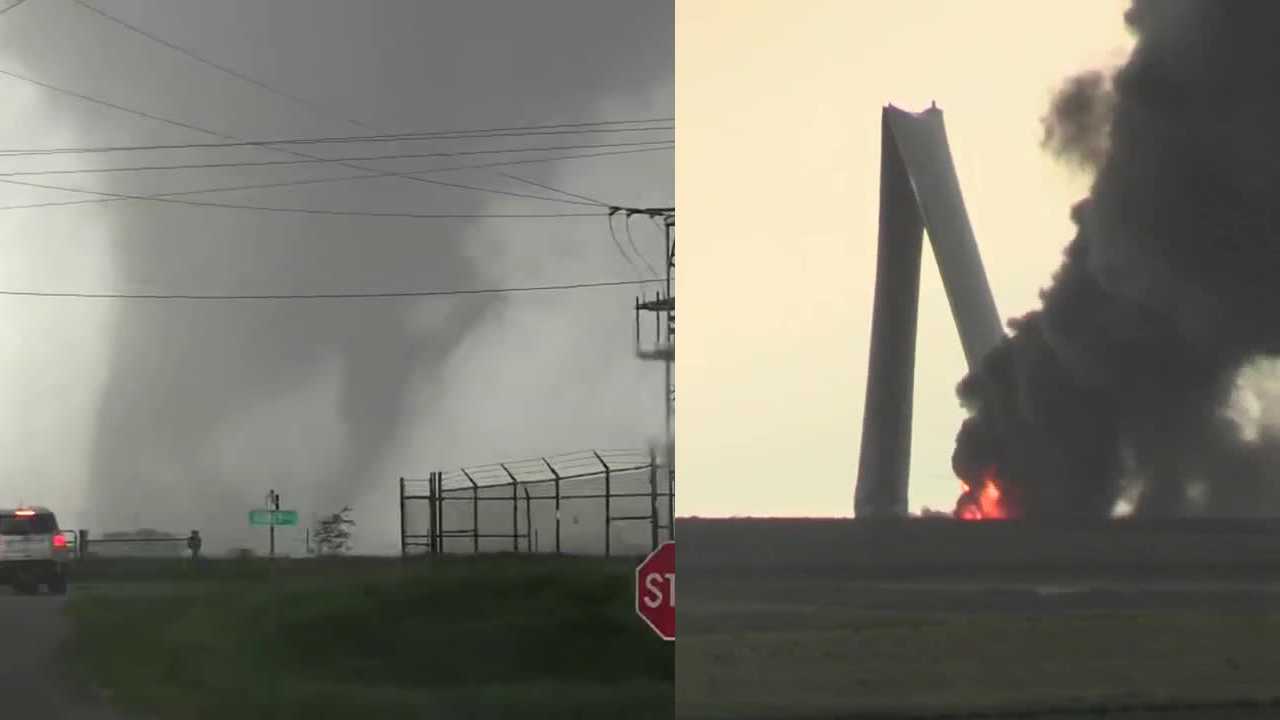Iowa Tornado History

Iowa tornados – Iowa, situated in the heart of Tornado Alley, has a long and turbulent history with these powerful storms. The state’s flat terrain and proximity to warm, moist air from the Gulf of Mexico create a breeding ground for tornadoes.
Iowa tornados are a serious threat to the state, and it’s important to be aware of the risks and know what to do if a tornado warning is issued. For the latest information on tornado warnings in Iowa, visit tornado warning iowa . Iowa tornados can be deadly, so it’s important to take precautions and be prepared.
Iowa experiences an average of 50 tornadoes annually, ranking it among the top five tornado-prone states in the United States. These storms range in intensity, with some reaching EF5 status, the highest rating on the Enhanced Fujita Scale.
Iowa tornados have been a destructive force in the state’s history, leaving behind a trail of devastation. To better understand the impact of these storms, it’s helpful to consult a detailed greenfield ia map . By examining the geographic distribution of past tornadoes, we can identify areas that are particularly vulnerable to future events and take steps to mitigate their impact.
Significant Iowa Tornadoes
- May 6, 1878: The Sioux City tornado, an EF5 event, killed 30 people and injured over 100 in Sioux City.
- June 13, 1950: The Waterloo tornado, an EF4 event, killed 7 and injured 214 in Waterloo.
- May 25, 2008: The Parkersburg tornado, an EF5 event, killed 9 and injured 70 in Parkersburg.
Tornado Alley and Iowa: Iowa Tornados

Iowa is situated in the heart of Tornado Alley, a region of the central United States that experiences a high frequency of tornadoes. This region is characterized by warm, moist air from the Gulf of Mexico meeting cold, dry air from the north, creating ideal conditions for the formation of severe thunderstorms and tornadoes.
Iowa has a long history of tornadoes, with an average of 50 tornadoes reported each year. The most recent tornado was reported yesterday, and you can find more information about it iowa tornado today . Iowa tornadoes can be devastating, but the state has a number of resources in place to help communities recover.
Factors Contributing to Tornadoes in Tornado Alley
Several factors contribute to the formation of tornadoes in Tornado Alley, including:
- Strong wind shear: The difference in wind speed and direction between the ground and upper atmosphere creates a rotating column of air that can become a tornado.
- Abundant moisture: The warm, moist air from the Gulf of Mexico provides the necessary fuel for thunderstorm development.
- Flat terrain: The lack of significant topographic barriers allows thunderstorms to move freely and grow in size.
Frequency and Severity of Tornadoes in Iowa, Iowa tornados
Iowa is one of the states most frequently affected by tornadoes in Tornado Alley. On average, Iowa experiences around 50 tornadoes per year, with some years seeing as many as 100. The state has also experienced some of the most destructive tornadoes in U.S. history, including the 1979 Wichita Falls tornado and the 2011 Joplin tornado.
Iowa tornadoes have caused widespread devastation throughout the state, including the severe greenfield tornado damage . The aftermath of these storms has left many communities reeling, as they work to rebuild and recover from the destruction. The impact of the Iowa tornadoes is a stark reminder of the importance of preparedness and the need for continued support for those affected by these devastating events.
Compared to other states in Tornado Alley, Iowa’s tornadoes tend to be more frequent but less severe. This is because Iowa is located in the northern part of Tornado Alley, where the storms are typically smaller and weaker than those that occur further south.
Tornado Safety and Preparedness

Tornadoes are unpredictable and can cause widespread damage. It is important to be prepared and know what to do if a tornado warning is issued.
There are several things you can do to stay safe during a tornado warning:
- Take shelter in a sturdy building.
- Go to the lowest level of the building.
- Stay away from windows and exterior walls.
- Cover your head and neck with a blanket or pillow.
Types of Tornado Shelters
There are two main types of tornado shelters: above-ground shelters and underground shelters.
Above-ground shelters are typically located in schools, churches, or other public buildings. They are designed to withstand high winds and flying debris.
Underground shelters are typically located in basements or storm cellars. They are designed to protect people from tornadoes and other severe weather events.
The best type of tornado shelter for you will depend on your individual needs and circumstances.
Emergency Plan for Tornadoes
It is important to have an emergency plan in place for tornadoes. Your plan should include the following:
- A list of safe places to shelter in case of a tornado warning.
- A plan for how to evacuate your home if necessary.
- A list of emergency supplies, such as food, water, and first-aid kits.
By following these tips, you can help keep yourself and your family safe during a tornado.
Tornado Impact on Iowa Communities
Tornadoes have a profound impact on Iowa communities, leaving behind a trail of destruction that can take years to recover from. The economic and social costs of tornadoes can be staggering, affecting infrastructure, businesses, and residents alike.
One of the most significant impacts of tornadoes is the damage they cause to infrastructure. Homes, businesses, schools, and other buildings can be destroyed or severely damaged, leaving residents homeless and businesses unable to operate. The cost of repairing or replacing damaged infrastructure can be enormous, placing a strain on local governments and economies.
Economic Impact
- Property damage: Tornadoes can cause extensive property damage, destroying homes, businesses, and other structures. The cost of rebuilding can be overwhelming for communities, especially those with limited resources.
- Business disruptions: Tornadoes can disrupt businesses, causing them to close temporarily or even permanently. This can lead to lost revenue and job losses, further impacting the local economy.
- Agricultural losses: Iowa is a major agricultural state, and tornadoes can cause significant damage to crops and livestock. This can lead to lost income for farmers and ranchers, as well as disruptions in the food supply chain.
Social Impact
- Displacement: Tornadoes can displace residents from their homes, forcing them to seek shelter in temporary housing or with family and friends. This can be a traumatic experience, especially for those who have lost everything.
- Health impacts: Tornadoes can cause injuries and even death. They can also damage or destroy hospitals and other medical facilities, making it difficult for people to access the care they need.
- Mental health impacts: Tornadoes can have a lasting impact on the mental health of survivors. They may experience anxiety, depression, and post-traumatic stress disorder (PTSD).
Despite the devastating impact of tornadoes, Iowa communities have shown remarkable resilience in the face of adversity. In the aftermath of a tornado, residents often come together to help each other rebuild and recover. Local governments and organizations also provide assistance, offering financial aid, housing, and other support services to those in need.
The story of Iowa’s recovery from the 2011 Joplin tornado is a testament to the strength and resilience of the state’s communities. After the tornado destroyed much of the city, residents and volunteers from across the state came together to help rebuild. Within a few years, Joplin had rebuilt and was thriving once again.
Tornado Research and Mitigation
Understanding and predicting tornadoes, as well as mitigating their impact, are crucial aspects of tornado management. Research plays a vital role in advancing our knowledge about these powerful storms, while technology provides valuable tools for tracking and monitoring them. Additionally, mitigation efforts aim to reduce the devastation caused by tornadoes.
Research and Understanding
Research helps us comprehend the formation, behavior, and characteristics of tornadoes. Scientists study atmospheric conditions, wind patterns, and cloud formations to identify factors that contribute to tornado development. Advanced computer models simulate tornado dynamics, enabling researchers to gain insights into their behavior and predict their paths more accurately.
Technology for Tracking and Monitoring
Technological advancements have significantly improved our ability to track and monitor tornadoes. Doppler radar systems detect and measure wind speeds and directions, providing real-time information about tornado formation and movement. Satellite imagery and aerial reconnaissance help identify potential tornado-producing thunderstorms and track their progress.
Mitigation Efforts
Mitigation strategies focus on reducing the vulnerability of communities to tornadoes. Building codes and construction standards are enforced to ensure structures can withstand high winds and debris impacts. Storm shelters and safe rooms provide designated areas for people to seek refuge during tornadoes. Public education and awareness campaigns promote tornado safety and preparedness, empowering individuals to take necessary precautions.
Iowa is no stranger to tornadoes, and the recent tornado in Iowa today is a reminder of the destructive power of these storms. While tornadoes can occur anywhere in the state, they are most common in the central and northern regions.
Iowa’s tornado season typically runs from April to June, but tornadoes can occur at any time of year.